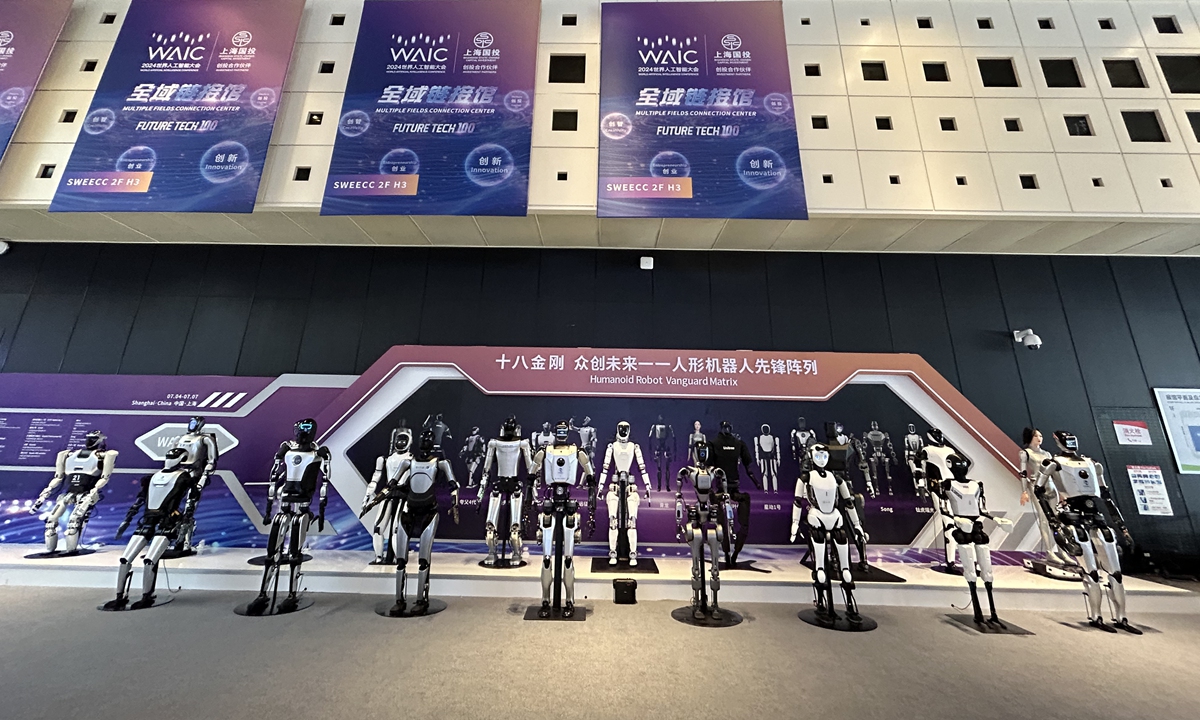
A lineup of 18 humanoid robots formed a vanguard matrix at WAIC Shanghai on Thursday. Photo: Qi Xijia/ GT
Chinese-manufactured humanoid robots are fast catching up with global rivals, company representatives at an industry expo told the Global Times on Thursday. The mastery of core technologies and China's complete industrial chain advantages may mean countries like the US may have to rely on China's manufacturing capabilities and industrial infrastructure for producing humanoid robots, according to industry insiders.
As the world enters the artificial intelligence (AI) era, humanoid robots and embodied intelligence are becoming increasingly popular tech concepts.
On Thursday, Tesla unveiled its highly-anticipated humanoid robot Optimus Gen2 model at 2024 World AI Conference and High-Level Meeting on Global AI Governance (WAIC) in Shanghai, marking the first appearance of the robot in China and highlighting the "great importance the company attached to the WAIC amid China's rapid AI development," according to a Tesla employee at the venue.
Tesla's Optimus model was met with a cohort of 18 humanoid robots designed by Chinese manufacturers, which demonstrated their fine motor skills and engaged in friendly interactions with attendees.
Shanghai-based Dataa Robotics debuted its humanoid bipedal robot the XR4 on Thursday. The XR4 is available for pre-sale and orders have been placed, Dataa's CEO Huang Xiaoqing told the Global Times on Thursday.
The Shanghai-based National and Local Co-Built Humanoid Robotics Innovation Center launched its full-size universal humanoid robot named "Healthy Loong." The robot can engage in fast walking, swiftly avoid obstacles and steadily mount up and down slopes, according to Yang Zhengye, the company's marketing director.
Yang told the Global Times that by collaborating with leading industrial partners, there will be more updates and iterations in the next two years.
Since the emergence of ChatGPT, robotics companies have been striving for more intelligent and more human-like robots along the path of embodied intelligence.
"China's humanoid robot industry is gaining its competitive edge in the market, narrowing the gap with its US counterparts," Huang said.
Currently, some domestic robots are now matching the performance and features of their international counterparts. The company has achieved complete technological independence in producing all core components of Dataa's robot joints, including speed reducers and other materials, according to Huang.
Equipped with cutting-edge technologies such as AI, machine learning and computer vision systems, these human-like robots have made significant advancements in a wide range of application scenarios including in the manufacturing and services industries, showcasing their sophisticated capabilities and potential for further development, Huang added.
Huang highlighted China's well-developed manufacturing industry with complete supply chains, saying that China's advantage in the electromechanical manufacturing industry provides a solid foundation for the production of humanoid robots. In future, countries like the US may have to rely on China's manufacturing capabilities and industrial infrastructure for producing humanoid robots, he claimed.
However, in the face of fierce global competition, the Chinese humanoid robot industry still needs to ramp up efforts in research and development to enhance technological innovation and product quality, experts said.
Key factors to be addressed include improving the robots' ability to understand and respond to human emotions, enhancing their adaptability to different environments, and ensuring their safety and reliability in everyday use, Jiang Lei, a Shanghai-based robotics expert told the Global Times.
Additionally, making robots more affordable and user-friendly will be crucial in bridging the gap between the ideal vision of humanoid robots and the reality of their widespread adoption, he added.
"The future is a robotic one," according to Jiang, who believes that in the near future, human-like robots will be as popular as new-energy vehicles.
The humanoid robotics industry in China is rapidly advancing, with major tech companies gearing up for mass production, signaling a significant step toward commercialization. On Monday, Shenzhen-based UBTECH Robotics and joint venture automaker FAW-Volkswagen announced they will work together on developing highly intelligent and flexible production lines, as well as an unmanned car factory, the Xinhua News Agency reported.
China's humanoid robot sector is set to grow faster than the global average. By 2024, the market is expected to reach 2.158 billion yuan ($298.02 million), increasing to nearly 38 billion yuan by 2030. The sales volume is predicted to rise from around 4,000 units to 271,200 units during this period, indicating huge potential in the Chinese humanoid robot market, according to the estimation of Gaogong Industrial Institute, a Chinese think tank on emerging industries.




